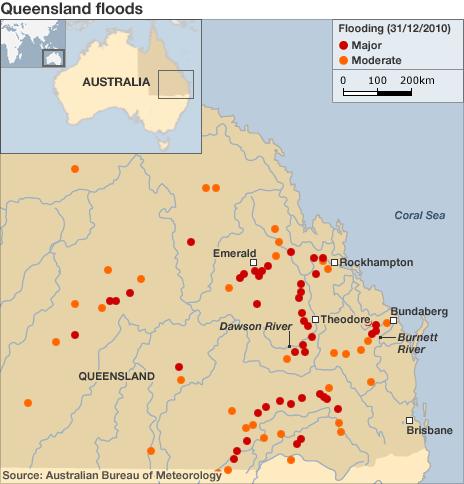Australia: Queensland floods spur more evacuations
- Published

There are major concerns for the town of Emerald, now largely cut off by water
Thousands more people are preparing to evacuate their homes as one of Australia's worst floods continues to inundate the state of Queensland.
Forced evacuations are being planned in Rockhampton as rising floodwaters threaten the town of 77,000.
Australian PM Julia Gillard has visited flooded Bundaberg, and flew over Emerald as evacuations there continued.
The floods have affected about 200,000 people over an area larger than France and Germany, Queensland's premier says.
An estimated 22 towns have been left isolated or inundated by the rising waters, with fears that damage could cost billions of Australian dollars to repair.
The situation in Emerald - a town of some 11,000 people - was particularly bad, Premier Anna Bligh told reporters.
There was also major concern for Rockhampton, where residents are said to be attempting to stockpile bread and fresh fruit and vegetables.
"We've seen lots of panic buying of food. Shelves in shopping centres are empty," Rockhampton resident Petros Khalesirad told the BBC.
"But I think people have been over-reacting. We have groceries arriving today and in the worst case scenario, the military will be involved in helping."
Officials in Rockhampton - where the floods peak could be up to 48 hours away - said a shift was under way from voluntary evacuations to compulsory relocation.
"Police will order people in affected areas to leave their homes," Mayor Brad Carter said.
Elderly people and other at-risk groups would be the first moved out of their properties, officials said.
Speaking as she toured affected areas with the prime minister, Ms Bligh described the flooding as "a long way from over".
"Authorities think there will be a very large group of people who will be homeless in the next 24 hours.
"We now have three major river systems in flood; we have 17 evacuation centres active; we have more than 1,000 people in those evacuation centres and many more thousands staying with relatives and friends."
Helicopter evacuations
Officials said the situation in Emerald remained uncertain and could yet get worse if floodwaters continue to rise.
The Nogoa River was due to peak on Friday afternoon, and 1,200 residents had already registered as evacuees before the waters hit their peak.
Helicopters including army Black Hawks have been ferrying residents to safer locations.
More than half of Queensland is now a disaster zone
Julia Gillard and Anna Bligh were due to visit Emerald on Friday but were unable to land, instead flying over the area to get an aerial view of the devastation.
Ms Gillard's first stop on land was in Bundaberg, which has seen its worst flooding for four decades and has been split in two by the swollen Burnett River. Waters there are now receding.
She spoke to evacuees and volunteers, and was briefed on the rescue and recovery effort.
"As devastating as these floods are, we are seeing a magnificent response by all levels of government and by emergency personnel," Ms Gillard said.
Two smaller towns, Theodore and Condamine, have been completely evacuated. In Condamine some residents had been refusing to leave their houses.
Recovery work following the floods is expected to cost billions of dollars, with officials warning of severe damage to homes, crops and livestock.
Sewerage systems have also been affected, raising public health concerns.
Petros Khalesirad told the BBC that Rockhampton was well-prepared but the effect on Queensland as a whole would be significant.
"These floods are going to affect the state, the whole nation. It's going to have a huge impact on mining commodities - several coal mines are under water and some won't be operational for months."

- Published1 January 2011
- Published30 December 2010
- Published29 December 2010
- Published27 December 2010